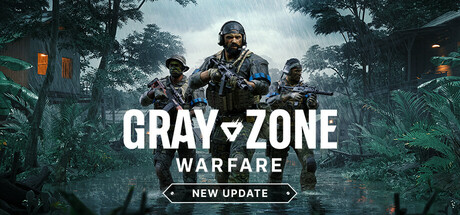Gray Zone Warfare’s “Winds of War”: A Storm of Change and Community Scrutiny
Gray Zone Warfare (GZW), the tactical shooter from MADFINGER Games, carved out its space in a crowded market with an ambitious Early Access launch, promising a realistic, immersive experience on the island of Lamang. Its journey has been one of notable potential, punctuated by community feedback on core mechanics, performance, and the overall player experience. Now, the “Winds of War” update (Update 0.3) has arrived, presented by the developers as a landmark overhaul, significantly shaped by player input and poised to redefine the game’s trajectory. This update is more than a collection of fixes and additions; it signals a clear intent for GZW’s evolving identity.
The developers have consistently framed “Winds of War” as an update “built on community feedback” , a narrative that naturally cultivates high expectations among its player base. However, this “community-driven” approach has faced early tests. Decisions such as granting exclusive early access to the update to a select group of streamers sparked considerable debate. Portions of the community, many of whom are paying Early Access supporters, voiced feelings of being undervalued compared to the marketing reach offered by content creators. This situation creates an inherent tension: if the update is a true reflection of community desires, the rollout strategy has, for some, cast a shadow on that claim. The ultimate success of “Winds of War” and subsequent updates will likely be measured not only by the features delivered but also by whether the broader community feels genuinely heard and respected throughout the entire development and release process.
Adding another layer to these changes is a subtle but potentially significant shift in how Gray Zone Warfare is being described. Some reports now categorize the game as an “MMOFPS” rather than purely an “extraction shooter” , a label also used on the game’s official website. While “extraction shooter” evokes specific gameplay loops often compared to titles like Escape from Tarkov, “MMOFPS” suggests a more persistent, large-scale world with potentially different long-term engagement systems. Indeed, key features introduced in “Winds of War,” such as capturable Combat Outposts and dynamic Conflict Zones , align with the concept of an ongoing, MMO-like struggle for territory and influence across Lamang. This rebranding could be a strategic move to further differentiate GZW and manage player expectations, signaling a broader ambition. However, it also underscores the critical need for robust server infrastructure and complex systems capable of supporting these large-scale, persistent interactions—a considerable long-term undertaking.
What’s in the Storm? Key Features of the “Winds of War” Update
The “Winds of War” update introduces a sweeping array of changes and new content, touching nearly every aspect of the Gray Zone Warfare experience. From player-versus-player engagements to environmental interactions and core progression systems, the island of Lamang has been significantly reshaped.
A. PvP Overhauls: Contesting Lamang
A primary focus of Update 0.3 is the revitalization of player-versus-player combat, aiming to transform Lamang into a more consistently “lawless, contested battlefield”. Previously, PvP could feel sporadic; this update introduces systems designed to foster more frequent and meaningful engagements.
- Combat Outposts (COPs): Over 30 strategic locations across the map can now be captured and controlled by factions. These outposts offer tangible benefits, including access to vendors—with major COPs hosting the new “Vulture” vendor who sells “special” gear, some potentially recovered from defeated operators—and crucial alternative spawn points. This mechanic aims to decentralize action from the main operating bases and reduce the often lengthy travel times.
- Conflict Zones: When PMCs from opposing factions clash, dynamic markers now appear on the map, signaling an active firefight. This system allows other players to consciously decide whether to join the fray or steer clear, making PvP encounters more telegraphed and potentially more consensual.
- Friend-or-Foe (FoF) System: To mitigate accidental friendly fire, a persistent issue in tactical shooters, players of the same faction now wear colored armbands. Further visual and audio cues have been implemented to aid in identification. Based on initial feedback during previews, these armbands were updated to include IR reflective material for better visibility with night vision goggles.
- Experience for PMC Kills: Engaging and successfully eliminating enemy PMCs within an active Conflict Zone now awards experience points , directly incentivizing participation in these new dynamic PvP events.
These PvP enhancements are interconnected. Combat Outposts serve as new focal points for conflict, offering strategic advantages that factions will likely fight to control. The revamped task flow, which aims to reduce helicopter dependency, is supported by COPs acting as forward operating bases. Mortars, another significant addition, become powerful tools for both assaulting and defending these outposts, with their effectiveness and frequency of use tied to the game’s rebalanced economy. However, this interconnectedness could also lead to new challenges. If COPs become overly central to progression or if the Vulture vendor offers uniquely powerful gear, it might create new imbalances or concentrate conflict too heavily around these specific points, potentially leading to a different form of gameplay bottleneck.
B. Dynamic Weather and Environmental Impact: Lamang Comes Alive
The environment of Lamang itself has received a significant upgrade with the introduction of a dynamic and realistic weather system.
- Players will now contend with tropical storms, rain, fog, and variable wind conditions, all of which impact visibility and gameplay tactics during both day and night cycles. The developers even partnered with Meteosource to enhance the authenticity of these weather patterns.
- Weather effects are not merely cosmetic; scopes can become fogged, heavy rain may obscure night vision capabilities, and the choice of headgear now carries more tactical weight. Furthermore, the weather will influence player vitals, such as hydration and energy consumption, and affect NPC senses like hearing and sight.
- Beyond weather, the island has been expanded with over 60 new smaller points of interest and new biomes, such as Meadow and Rock Vegetation, enriching the exploratory aspect of the game.
The dynamic weather system directly influences the viability of holding COPs or launching offensive actions like mortar strikes. Heavy fog, for instance, could dramatically alter the tactical landscape for both attackers and defenders.
C. Expanded Arsenal and Fire Support: New Tools of Engagement
Operators in Lamang now have access to an array of new weaponry and support options.
- New Weapons: The update introduces four new firearms: the iconic Dragunov SVD sniper rifle, the Heckler & Koch MP7 submachine gun, the SIG MCX assault rifle chambered in.300 Blackout, and two new sidearms, the Beretta M9A1 and the Colt Combat Commander.
- Weapon Parts & Ammunition: Complementing the new firearms are over 80 new weapon parts and two new ammunition types, allowing for greater customization and tactical flexibility.
- Mortar Strikes: Previously static props, mortars are now functional, allowing players to call in devastating fire missions on designated targets. This adds a powerful, albeit expensive, area-denial and offensive capability.
- Tracking Tags: Addressing a community request, players can now purchase “AirTag-like” devices to attach to their gear. These tags allow for the tracking of lost equipment, potentially aiding in recovery after death.
D. AI Evolution (and the Infamous “Guts”): Smarter, Tougher Foes?
The artificial intelligence populating Lamang has undergone several changes aimed at making encounters more believable and tactically engaging.
- NPC Readability & Animations: NPCs now exhibit improved animations for various states, such as checking their injuries, limping when critically wounded, reacting to flashbangs, and even a specific animation for when a headshot ricochets off their helmet. Additionally, some NPCs will now issue warnings before opening fire.
- The “Guts” Organ: A new vital organ, “guts,” has been added to the lower abdomen of NPCs. If destroyed, it will result in a coma, a change intended to address community feedback regarding the perceived “sponginess” of AI when shot in this area.
- Health System Enhancements: The update brings more detailed health symptoms for players (e.g., sore arms, vomiting, tremors) and provides more information regarding injuries.
These changes walk a fine line between realism and gameplay. The introduction of the “guts” mechanic and more detailed injury feedback pushes towards a more realistic damage model. However, this pursuit of realism must be carefully balanced against player experience. Early community feedback on the update has indicated that, for some, AI can feel overly sensitive or possess “aimbot-like” accuracy. If AI becomes realistically lethal but is also perceived as unfair due to opaque mechanics or bugs, it can significantly detract from the enjoyment of encounters. The new headshot ricochet animation is a positive step in providing clearer feedback to players during firefights , and continued tuning will be essential to ensure AI provides a challenge that feels fair, even when difficult.
E. Quality of Life (QoL) and Progression: Smoothing the Experience
A significant portion of the “Winds of War” update is dedicated to quality-of-life improvements and refinements to progression systems, addressing numerous player pain points.
- Task Flow Revamp: A major change is the ability to accept and complete selected tasks directly in the field, significantly reducing the need for repeated helicopter trips back to base. Furthermore, elimination tasks now feature shared progression for all squad members , and the starter town questlines have been streamlined for faster progression to other points of interest.
- Locker & Inventory Management: Player lockers now feature sorting capabilities, and new dedicated containers for items like grenades and weapon parts have been added, along with updates to existing container sizes. Money also now auto-sorts into stacks, a widely appreciated convenience.
- Performance Adjustments: The lowest graphical settings have been adjusted to aim for improved performance on PCs that meet the minimum required specifications.
- Economy Rebalancing: Changes have been made to loot tables, with more crates, including hidden variants, and field-found gear intended to feel more valuable and practical. Restocking mechanics and vendor progression have also been rebalanced.
- Numerous Other QoL Enhancements: The update includes a long list of other improvements, such as smooth zoom adjustment for optical scopes, enhanced key binding options (including proper double-press functionality), improved matchmaking logic, a faction balance bonus for players joining less populated factions, an in-game bug reporting tool, Steam friends integration, various audio enhancements, and a manual respawn option for players who get stuck in terrain.
F. The Full Wipe: A Fresh Start for All
As is common with major Early Access updates that introduce significant systemic changes, “Winds of War” was accompanied by a full progress wipe, resetting all player accounts. The developers state that such wipes are essential during the Early Access phase to implement substantial changes, rebalance the game experience effectively, and continue building the game in collaboration with the community.
While wipes are a generally accepted, if sometimes begrudged, part of the Early Access journey, particularly for games undergoing major economic and progression overhauls, they always touch upon the sensitive subject of the perceived value of player time and investment. The introduction of enhanced game editions alongside this update, which offer better starting gear post-wipe , may be viewed by some as a way to acknowledge and reward paying supporters, helping them get back on their feet more quickly. Conversely, others might see this as perpetuating an advantage. The true test will be how the new economy and progression systems feel to the player base at large. If progression is perceived as too slow, unrewarding, or if the benefits of the wipe—such as a smoother progression curve or a fairer economy—are not immediately tangible, it could leave a lingering dissatisfaction for some players, potentially impacting their enthusiasm to reinvest significant time.
Through the Streamer Scope: Early Access Impressions and Hot Takes
MADFINGER Games employed a common marketing strategy for the “Winds of War” rollout, providing select streamers and content creators with early access to the update from May 17-21, ahead of the public release on May 22. This preview period was likely intended for generating hype, showcasing new features, and possibly gathering some final feedback.
This early access was heavily promoted through an extensive Twitch Drops campaign. Viewers watching participating streams could earn exclusive in-game apparel and a variety of consumable items, such as repair kits, medical supplies, weapons, and even mortar strike shells. Prominent streamers listed as “Elite Operators” for this campaign included names like Pestily, Klean, Nothing But Skillz, BigFry, and JesseKazam, among many others, ensuring a wide reach within the tactical shooter community. While this approach can be effective for visibility, it also generated considerable discussion and, in some cases, friction within the GZW player base who were awaiting public access.
A. Streamer Praise: What Hit the Mark?
Initial impressions from streamers who had early access highlighted several positive aspects of the “Winds of War” update.
- Quality of Life and Immersion: Many content creators and their audiences expressed appreciation for the numerous QoL improvements. Features like automatic money sorting, quicker inventory cleanup, refined character movement, and enhanced ambient and gunshot sounds were frequently praised. The new dynamic weather system was often singled out for its visual fidelity and its contribution to a more immersive atmosphere.
- PvP Potential: The introduction of Combat Outposts and Conflict Zones was generally seen as a promising development for creating more dynamic, engaging, and meaningful PvP encounters. This directly addressed a common request from players who found the previous iteration of PvP in GZW to be lacking in consistent action. The positive engagement of streamers like HollywoodBob with the new PvP content reportedly influenced some viewers to purchase the game.
- Performance (for some): A subset of streamers, particularly those equipped with high-end PCs and newer generation graphics cards (specifically 40-series GPUs), reported experiencing smooth performance, even with the demanding new weather effects active.
- Reduced Helicopter Dependency: The ability to manage tasks while deployed in the field, thereby reducing the reliance on lengthy and sometimes tedious helicopter flights back to base, was noted as a significant improvement to the gameplay flow.
It’s worth noting that streamers often operate with high-specification gaming rigs, which might not always reflect the average player’s hardware. This “streamer bubble” can sometimes lead to a perception of performance or stability that differs from the broader community experience. Furthermore, early access builds provided to content creators may occasionally be more stable or curated than the initial public release versions. Developers relying heavily on this tier of feedback must balance it with data from wider testing and telemetry to get a comprehensive picture.
B. Streamer Criticisms and Concerns: Where the Winds Faltered
Despite the positives, streamer playthroughs and community discussions surrounding them also brought several criticisms and concerns to the forefront.
- AI Behavior: A recurring and significant complaint revolved around the behavior of AI enemies. Many streamers and their viewers felt that the AI had regressed to “early access levels,” exhibiting overly sensitive detection, “aimbot-like” accuracy, and an uncanny ability to hear players even through environmental mufflers like rainstorms. Some commentators, like SMYYYLE on Reddit, noted instances of AI surviving multiple headshots, despite the introduction of new mechanics like the “guts” system intended to address durability.
- Performance Inconsistencies: While some streamers enjoyed smooth gameplay, many others, and by extension their communities, highlighted persistent or even worsened performance issues. Reports of significant FPS drops and stuttering were common, particularly for players using mid-range or older hardware. Notably, some users with 30-series NVIDIA GPUs reported a performance decrease after the update. This remains a critical barrier to enjoyment for a substantial segment of the potential player base.
- Loot Scarcity and Balance: Concerns were raised by some streamers and viewers regarding the perceived scarcity of item drops. In some instances, key items, such as the Tiger Bay container key, were reported as no longer dropping, leading to frustration. Broader questions about the overall value of loot relative to the risk involved in acquiring it also surfaced.
- Streamer Experience vs. Update Quality: There were instances where a streamer’s unfamiliarity with Gray Zone Warfare’s mechanics or technical difficulties encountered during their broadcast led to a negative viewing experience. This could, at times, inadvertently misrepresent the update’s actual quality or features. For example, one user reported watching streamer Lirik spend a significant portion of a short playtime on keybinds before abandoning the game after a single death, leading to a negative chat reaction. Another viewer observed a streamer who found valuable new loot but seemed largely indifferent to it. The primary goal of a streamer is often entertainment, which might lead to a focus on high-action PvP or dramatic moments, potentially overlooking deeper systemic issues or the nuances of PvE gameplay unless the streamer is particularly dedicated to the game.
The Twitch Drops campaign, while effective for driving viewership, also presents a nuanced impact on player onboarding. The consumable items offered, such as gear and mortar shells, were intended to help players “ease into the new update more easily” and “try the new content faster”. For new players drawn in by streams, these drops could indeed provide a smoother initial experience. However, these items are temporary—lost on death and subject to removal in the next major game wipe (Update 0.4). This could create an artificial sense of progression or a temporary inflation of well-equipped players, potentially leading to a jarring experience for newcomers once the drops cease or if they miss the campaign entirely. They might then face a harsher early game than what they observed streamers (who were possibly boosted by these drops) experiencing, raising questions about the “true” balance of the early-game loot economy. The exclusive apparel rewards, however, are permanent cosmetic additions.
The Community Echo Chamber: Wider Player Reactions and Debates
Beyond the focused lens of streamer previews, the broader Gray Zone Warfare community has been vocal with their impressions of the “Winds of War” update, leading to a spectrum of reactions and ongoing debates.
A. The Good: What the Broader Community Appreciated
Many players echoed the positive sentiments observed in streamer circles, particularly concerning tangible improvements to the gameplay experience.
- Quality of Life is King: The myriad QoL enhancements were widely praised. Features such as automatic money sorting, more intuitive inventory management, smoother character movement, updated sound design, and the immersive impact of the new weather system received positive feedback. The ability to complete tasks in the field without constant returns to base was a significant and frequently highlighted win.
- Renewed Hope for PvP: A considerable portion of the community expressed excitement about the potential of Combat Outposts and Conflict Zones to invigorate PvP. These systems are seen as a way to make player encounters more meaningful and less reliant on chance or camping at extraction points.
- Performance Gains (for some): Similar to streamer experiences, there were reports from general players of improved FPS and smoother gameplay, especially from those with newer 40-series graphics cards or those who found optimal settings configurations.
- AI (Positive Aspects): Some players found the AI to be “actually good now” and, interestingly, “easier at night,” with particular praise for the game’s night vision goggle implementation. The new NPC animations and behaviors were also noticed and appreciated by some.
B. The Bad and The Ugly: Community Frustrations and Concerns
Despite the positive developments, significant frustrations and concerns persist within the player base.
- AI Regression and Difficulty Spikes: This was arguably one of the most common and vehement complaints. Many players reported the AI feeling unfairly difficult, “too sensitive,” akin to “aimbots,” and capable of detecting players with uncanny accuracy, even in adverse weather conditions or through concealment. Comments such as “AI should not survive 4 headshots” were indicative of this frustration , suggesting that the intended improvements to AI combat effectiveness may have overshot the mark for many, leading to more frustration than challenge.
- Persistent Performance Woes: A large segment of the community continues to struggle with game performance. Reports of low framerates, stuttering, and, for some, even a degradation in performance after the update were widespread, particularly among players with non-latest-generation hardware. This performance divide is a major point of alienation for players who feel unable to enjoy the game adequately on their systems. The disparity in experience, where players with high-end GPUs (often 40-series) report good FPS while those with older or mid-range hardware (especially 30-series GPUs, some of which reportedly saw performance decreases ) struggle significantly, creates divergent perceptions of the update’s technical success and can lead to friction within community discussions.
- Loot Scarcity and Balance: Concerns were frequently voiced about scarce item drops, the apparent removal of previously available key item drops (like the Tiger Bay container key ), and the overall balance of risk versus reward in looting activities.
- Streamer Early Access Controversy: The decision to grant streamers early access while paying Early Access supporters had to wait generated significant backlash. Many players felt this was unfair, devalued their support, and diminished their excitement for the update. Polls conducted within community spaces indicated that a majority of participants disliked this approach. This sentiment suggests that while players understand the “Early Access” tag implies an unfinished product , their patience can wear thin, especially when perceived preferential treatment clashes with the spirit of collaborative testing. After over a year in Early Access (since April 2024 ), expectations for progress on fundamental issues are understandably higher.
- Game Stability: Despite numerous crash fixes listed in the patch notes , some players still reported experiencing game crashes after the update.
The state of AI post-update appears to be a critical litmus test for many players, determining whether their experience is one of enjoyable challenge or frustrating unfairness. The sheer volume and intensity of negative feedback regarding AI suggest its pivotal role in player satisfaction. Even with sophisticated new mechanics like the “guts” system designed to improve AI takedowns, the overriding perception of super-sensitivity or aimbot-like behavior can negate these improvements. If players consistently feel cheated by AI, it discourages engagement with core game content like tasks and exploration, especially in a game where gear loss is a significant penalty.
C. The Great Debate: PvP Focus vs. PvE Experience
The “Winds of War” update’s pronounced emphasis on enhancing PvP systems, such as Combat Outposts and Conflict Zones, has ignited a familiar debate within the community regarding the game’s overall direction and its commitment to the PvE player base.
Some players who primarily enjoy the PvE aspects of Gray Zone Warfare expressed concerns about being “abandoned” or that an increased focus on PvP might introduce more toxicity into the game environment. In response, developers (including “Mara,” a community manager on Reddit) and other community members have clarified that most of the new features, with the notable exception of Conflict Zones, are indeed available in the PvE-only mode. Combat Outposts, for instance, still serve PvE purposes such as providing alternative respawn points and restocking opportunities. The addition of new quests and numerous points of interest also directly benefits the PvE experience.
However, a counter-argument raised by some is that features clearly designed with PvP interactions in mind (like COPs facilitating inter-faction conflict) may not translate as meaningfully into a compelling PvE gameplay loop without specific PvE mechanics built around them. Simply making PvP content available in PvE doesn’t inherently make it engaging PvE content. On the other side of the discussion, some players maintain that a robust PvP element is necessary for the game’s long-term replayability and to keep the experience fresh and unpredictable, arguing that PvE alone can become stale over time.
Enhancing Value or Stirring the Pot? Analyzing the Update’s Aims
MADFINGER Games has positioned the “Winds of War” update as a direct response to community desires, aiming to enhance combat, evolve the game world, and deliver crucial quality-of-life upgrades. Specific examples cited by the developers as community-driven include the ability to manage tasks in the field, shared progression for squad elimination tasks, and the introduction of tracking tags for gear. The extensive changes touch upon nearly every facet of Gray Zone Warfare, fundamentally altering how the game is played and experienced.
The impact on replayability and engagement is potentially significant. The new PvP dynamics, fueled by Combat Outposts, Conflict Zones, and functional mortars , are designed to create emergent, player-driven narratives and a more dynamic struggle for control across Lamang. This has the potential to substantially boost replayability, especially for players who thrive on PvP. The dynamic weather system adds another layer of unpredictability, forcing adaptation and potentially making even familiar missions feel distinct with each playthrough. For all players, the revamped task system, over 60 new locations, streamlined starter progression, and new Strike Missions (squad-based real-time tasks) offer fresh content and new gameplay loops. Furthermore, the rebalanced economy and loot tables, along with the new Vulture vendor, aim to make progression and risk-taking more meaningful and rewarding.
This update successfully addresses several long-standing player pain points. The reduction in helicopter travel times due to in-field task management , clearer friend-or-foe identification , and more intuitive locker management are undeniable improvements. However, the update is not without its new or exacerbated challenges. The perceived unfairness of the AI and the inconsistent performance for a significant portion of the player base remain major hurdles. The reported scarcity of certain loot items or keys has also introduced new frustrations for some.
The “Winds of War” update appears to be shifting the definition of “value” within Gray Zone Warfare. Initially, its appeal might have centered on realistic tactical PvE with an undercurrent of PvP. This update heavily promotes the value of dynamic, large-scale PvP and territorial control through systems like COPs. Simultaneously, the extensive QoL improvements add value by reducing friction and demonstrating respect for player time. Gray Zone Warfare seems to be broadening its appeal, aiming to offer multiple avenues for players to find value, but this also carries the risk of diluting its original core identity if not carefully balanced. The game is arguably evolving from a niche “Tarkov with better PvE” into its own distinct “MMOFPS” entity.
However, the long-term viability of even highly requested, community-driven features hinges on the stability and functionality of core game systems. Features like tracking tags are clear wins based on player feedback. Yet, if foundational elements like AI behavior and game performance are not consistently enjoyable or reliable, the value added by these secondary features is diminished. Players might appreciate a new feature in theory but find themselves unable to enjoy it in practice due to underlying frustrations with core gameplay. This suggests a hierarchy of development needs: foundational stability and satisfying core gameplay loops must be solidly in place before additional content layers can truly maximize the game’s overall value.
The following table summarizes the aims of the “Winds of War” update against the perceived reality based on streamer and community feedback:
| Feature Area | Stated Developer Aim (Ex: ) | Positive Streamer/Community Reception (Example Comments/Sources) | Negative/Mixed Streamer/Community Reception (Example Comments/Sources) | Overall Impact on Value (Preliminary) |
|---|---|---|---|---|
| PvP Systems (COPs, Conflict Zones, FoF) | Enhance combat, create dynamic engagements, respond to calls for more PvP. | Excitement for more meaningful PvP, better FoF appreciated. COPs seen as good for decentralizing action. | Concerns about balance of COPs, potential for new bottlenecks. | Potentially High: If balanced, could significantly boost replayability for PvP players. |
| AI Behavior | Improve NPC readability, responsiveness, and tactical challenge; address “sponginess”. | Some find AI “good now,” NVG interactions praised, new animations noticed. “Guts” mechanic logically sound. | Widely criticized as “too sensitive,” “aimbot,” regression to early EA levels, surviving too many headshots. | Negative to Mixed: Currently a major source of frustration for many, undermining other improvements. |
| Performance & Stability | Improve performance on min-spec PCs, fix crashes. | Smooth performance for some with high-end/40-series GPUs. | Persistent issues for many, 30-series GPUs reportedly worse, stutters, FPS drops. Crashes still occur. | Mixed to Negative: A critical barrier for a large part of the player base, significantly impacting accessibility and enjoyment. |
| Quality of Life & Progression | Smoother gameplay, reduced travel, better inventory, streamlined tasks, community-requested features (tracking tags). | Widely praised: money sort, task flow, locker improvements, weather immersion, sound updates. | High: These changes are almost universally well-received and directly improve the moment-to-moment experience. | |
| Economy & Loot | Rebalance loot to be more valuable/practical, improve vendor progression. | More crates, potential for valuable finds noted. Vulture vendor adds intrigue. | Concerns about scarce drops, key items missing (Tiger Bay key), risk/reward balance questioned. | Mixed: Potential for a more rewarding loop, but current balance and specific item availability are points of concern. |
| Dynamic Weather | Deeper immersion, new tactical layer. | Visually impressive, adds to immersion, makes gameplay feel different. | High: Generally seen as a positive addition enhancing atmosphere and tactical considerations. |
Conclusion: Riding the “Winds of War” – What’s Next for Gray Zone Warfare?
The “Winds of War” update is undeniably a transformative and ambitious undertaking for Gray Zone Warfare. It has delivered a wealth of new content and implemented significant changes to core gameplay systems, particularly reshaping the landscape of player-versus-player combat on Lamang. MADFINGER Games has clearly signaled a commitment to evolving the game based on community feedback, and many of the additions reflect this intent.
However, the reception is nuanced. Features like the dynamic weather system, the revamped task flow reducing helicopter reliance, and many quality-of-life improvements have been largely welcomed by streamers and the wider community alike. These changes have the potential to significantly enhance the game’s value, immersion, and replayability. Yet, persistent and, for some, worsened issues with AI behavior and performance inconsistencies cast a considerable shadow over the update’s overall success. The controversy surrounding the streamer-exclusive early access also created friction within the community, a point developers may need to consider for future rollouts.
The true impact of “Winds of War” will continue to unfold as a larger portion of the player base dives into the altered world of Lamang and as MADFINGER Games responds with the “regular patches, hotfixes, and ongoing improvements” they have mentioned. Addressing the critical concerns surrounding AI fairness and performance optimization will be paramount for long-term player retention and for realizing the full potential that this ambitious update promises. The game’s published roadmap and the studio’s continued communication and responsiveness will be key indicators of its future health.
This update serves as more than just a content drop; it’s a significant stress test for Gray Zone Warfare’s development philosophy. How effectively MADFINGER Games addresses the negative feedback in the coming weeks and months will be a critical indicator of their ability to iterate and manage a complex live-service title. With each major update and wipe , a new “meta” invariably emerges, and players, often guided by streamers, will quickly seek to optimize their strategies around new systems like Combat Outposts and the rebalanced economy. The developers’ agility in monitoring these emergent player behaviors and making necessary balance adjustments will be crucial. The path forward for Gray Zone Warfare hinges not just on delivering substantial updates, but on actively curating the live environment these changes create, ensuring it remains engaging, fair, and accessible to its dedicated community.












Add comment